
Saint Ermin of Lobbes (died 737, in Lobbes, Hainaut, Belgium) was the second abbot of Lobbes Abbey.

Saint Ermin of Lobbes (died 737, in Lobbes, Hainaut, Belgium) was the second abbot of Lobbes Abbey.
Originally from the region of Laon, he studied at the Cathedral School of Laon (France) and was ordained as a priest by the bishop, Madalgaire.
After entering the Benedictine monastery of Lobbes, he became a disciple of Saint Ursmar. After nomination by Ursmar, he was elected as his successor as the head of the abbey, founded by Saint Landelin. He had a reputation for wisdom and sanctity. His biographer, abbot Anson of Lobbes (+800), stated that he also had a gift for prophecy.
He died in Lobbes in 737, and is interred in a sarcophagus in the crypt of Saint Ursmar's Church in Lobbes. He was succeeded as abbot by Theodwin.
Saint Ermin (Latin: Erminus) is celebrated locally as a Christian saint. His feast day is on 25 April.
Saint Wolbodo was the bishop of Liège from 1018 to 1021.

The Archdiocese of Cambrai is a Latin Church ecclesiastical jurisdiction or archdiocese of the Catholic Church in France, comprising the arrondissements of Avesnes-sur-Helpe, Cambrai, Douai, and Valenciennes within the département of Nord, in the region of Nord-Pas-de-Calais. The current archbishop is Vincent Dollmann, appointed in August 2018. Since 2008 the archdiocese has been a suffragan of the Archdiocese of Lille.
Carloman was the youngest son of Charles the Bald, king of West Francia, and his first wife, Ermentrude. He was intended for an ecclesiastical career from an early age, but in 870 rebelled against his father and tried to claim a part of the kingdom as an inheritance.

Prémontré Abbey was the mother house of the Premonstratensian Order and was located at Prémontré about twelve miles west of Laon, département of Aisne, France.
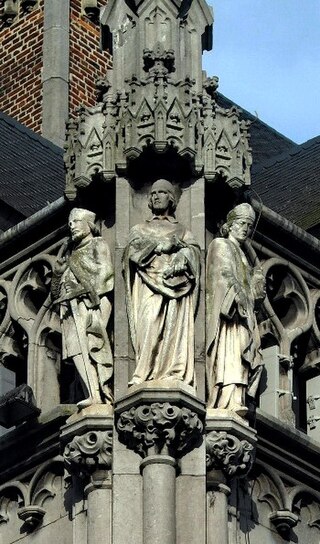
Ratherius or Rathier or Rather of Verona was a teacher, writer, and bishop. His difficult personality and political activities led to his becoming an exile and a wanderer.
Herigerus was a Benedictine monk, often known as Heriger of Lobbes for serving as abbot of the abbey of Lobbes between 990 and 1007. Remembered for his writings as theologian and historian, Herigerus was a teacher to numerous scholars. His biography describes him as "skilled in the art of music", though no music theory treatise survives and neither do the two antiphons and one hymn attributed to him.

Gembloux Abbey was a Benedictine abbey near Gembloux in the province of Namur, Wallonia, Belgium. Since 1860, its buildings host the University of Liège's Gembloux Agro-Bio Tech faculty and campus.
Lobbes Abbey was a Benedictine monastery in the municipality of Lobbes, Hainaut, Belgium. The abbey played an important role in the religious, political and religious life of the Prince-Bishopric of Liège, especially around the year 1000. The abbey's founding saint is Saint Landelin; four other saints are also connected with the abbey.
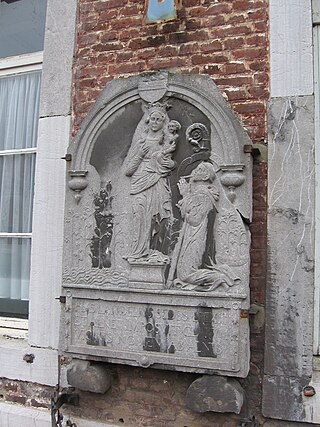
Saint Landelin is a saint in the Eastern Orthodox Church and Roman Catholic Church.

Abel served as the Bishop of Reims in Francia, now modern-day France. He has sometimes been venerated as a saint in the Catholic Church, particularly by the Bollandists.
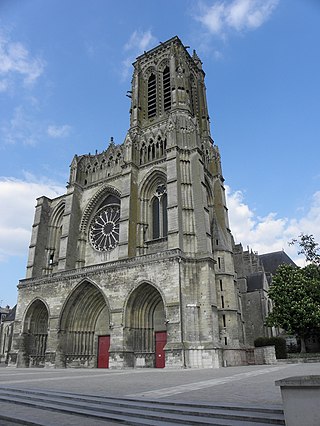
The Diocese of Soissons, Laon, and Saint-Quentin is a Latin Church diocese of the Catholic Church in France. The diocese is suffragan to the Archdiocese of Reims and corresponds, with the exception of two hamlets, to the entire Department of Aisne. The current bishop is Renauld Marie François Dupont de Dinechin, appointed on 30 October 2015. In 2022, in the Diocese of Soissons there is one priest for every 5,594 Catholics.

Saint Gerald of Sauve-Majeure, OSB, also known, from his place of origin, as Gerald of Corbie, was a Benedictine abbot.
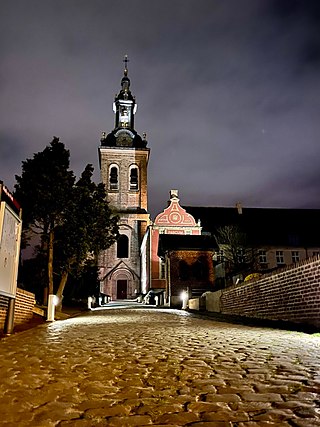
Park Abbey is a Premonstratensian abbey in Belgium, at Heverlee just south of Leuven, in Flemish Brabant.
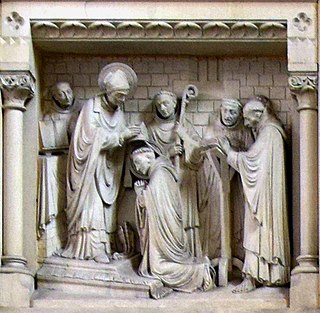
Ursmar of Lobbes was a missionary bishop in the Meuse and Ardennes region in present-day Belgium, Germany, Luxemburg and France. He was also the first abbot of Lobbes Abbey.
Herman of Tournai, Herman of Laon or Hériman of Tournai,, the third abbot of Saint Martin of Tournai, was a chronicler of his abbey and, in many anecdotal accounts connected with the abbey, a social historian of the world seen from its perspective. Forced from his abbacy in 1136 by a contingent within the monastic community that asserted he had been lax in his enforcement of the Benedictine rule, he had the leisure while at Rome to write his book, Restauratio sancti Martini Tornacensis, written in Latin about fifty years after a local plague of 1090. He was a pupil of Odoardus, later Bishop of Cambrai, whose example as a teacher he delineates at the start of his work, and who was the driving force behind the refounding of a neglected and undistinguished church dedicated to St Martin of Tours near Tournai. Herman's Restauratio has been edited and translated for the first time into English by Lynn Harry Nelson, who provided extended explanatory notes.

Crespin Abbey was a Benedictine monastery in the commune of Crespin in the department of Nord, France, founded around 648 by the reformed brigand Landelin of Crespin, also the first abbot, and dissolved in 1802.

The Abbey of St. Vincent, Laon was a Benedictine monastery in Laon, Picardy, northern France.
Erluin was a Benedictine monk, the first abbot of Gembloux (946–87) and also briefly the abbot of Lobbes (956–57). Diametrically opposed accounts of his character are given by the partisans of Gembloux and Lobbes.
Folcuin was a monk at the abbey of Saint-Bertin, where he was a deacon and archivist, and later abbot of Lobbes. He wrote histories of the abbots of both his monasteries.
Theodwin was abbot of Lobbes Abbey from 737 until his death some time around 750. During his abbacy he added Fontaine-Valmont to the abbey's domains. Unlike his predecessor, Ermin of Lobbes, and his successor, he was not a bishop alongside being abbot.